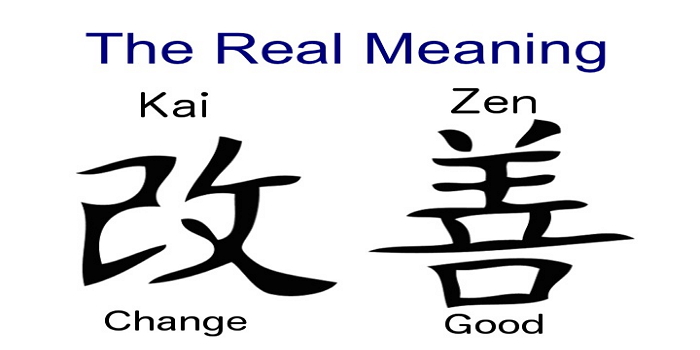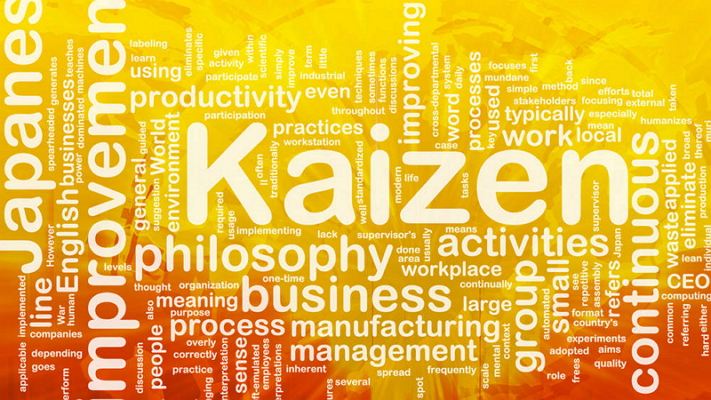Introduction to Kaizen
Efficient work and quality require clean environment, safety and discipline. So, the Japanese philosophy of Kaizen is simple and effective for tidiness. The Kaizen is prerequisites for any improvement programme.
Kaizen focuses on small, gradual and frequent improvements over the long term with minimum financial investment and participation by everyone.
Kaizen Philosophy focuses on effective workplace organization, simplifies work environment, and reduces waste while improving quality and safety. There is no hope for efficiency or quality improvement with dirty workplace, waste of time and scrap.
Meaning of Kaizen
The Japanese word “Kaizen” means change (KAI) to become good (ZEN).
KAI = CHANGE
ZEN = GOOD
 Kaizen means change for the better or “Continuous improvement“.
Kaizen means change for the better or “Continuous improvement“.
Kaizen was originated in japan. Basically Kaizen is a process to make an organization a better place to work for its employee.
In other words we can say that Kaizen is a workplace philosophy which focuses on making continuous small improvements which keep a business at the top of its field.
Kaizen is a vital process, which involves everyone in the organization such as managers and workers and urges them to make never-ending efforts for improvement.
Origin of Kaizen
The foundation of Kaizen was laid in Japan after the Second World War in 1939, when the country was attempting to rebuild infrastructure and rethink many systems.
Several American experts including W. Edwards Deming and Joseph Juran came to Japan to lecture and teach.
Using information from these individuals regarding the TWI (Training within Industry) programs, the concept of Kaizen began to be formed in the 1950s.
Key Principles
Basic principles of Kaizen are:
- Teamwork: The team as a whole is better and smarter than the quality sum of the individuals. By teamwork we mean a group of people from different departments within the company working together with a common goal.
- Discipline in the workplace: In an organization discipline is must for everyone. In Kaizen to make sure that the everything work properly discipline is must.
- Small group activities.
- Co-operative labour – management relations also helps in improvement.
- Continuous quality Improvement is the most important aspect of the Kaizen.
- Use of Quality Circles and workers group helps to improve quality of products.
Key Implementation Concepts
Some of the concepts inspired by Kaizen are:
1. “5 S” in Kaizen
The 5 Ss’ stands for the five first letters of these Japanese words, Seiri, Seiton, Seiso, Seiketsu and Shitsuke.
| 5S | MEANING |
| SEIRI | Sorting Out |
| SEITON | Systematic Arrangement |
| SEISO | Spick and Span |
| SEIKETSU | Standardizing |
| SHITSUKE | Self-Discipline |
Seiri (Sorting Out)
Sorting , keep the necessary in the work area, dispose or keep in a distant storage area less frequently used items, unneeded items are discarded.
Seiri helps to keep work area tidy, improves searching and fetching efficiency and generally clears much space.
Seiton (Systematic Arrangement)
Systematic arrangement for the most efficient and effective retrieval. A good example of Seiton is the tool panel. Effective Setion can be achieved by painting the floors to visualize the dirt, outlining work areas and locations, shadow tool boards.
Seiso (Spick and Span)
Daily follow-up cleaning is necessary in order to sustain this improvement. Regular cleaning is a type of inspection.
Seiso is an important part of basic TPM; Total Productive Maintenance and Safety matter through cleanliness is obvious.
Seiketsu (Standardizing)
Once the first three Ss’ have been implemented, it should be set as a standard so to keep these for good practice work area. Have easy-to-follow standards and develop a structure to support it. Allow employees to join the development of such standards.
Shitsuke (Self Discipline)
Finally, to keep first 4 Ss’ alive, it is necessary to keep educating people about standards.
For sustaining, maintaining discipline and reviewing standards; self-discipline is must for every person involved in the organization.
Quality Circles
The concept of Quality Circle was developed in Japan in 1962 and it quickly became popular and spread to more than 35 companies in the first year.
A Quality circle is a small group of employees in the similar work area who voluntarily meet regularly and whose assignment is to identify the problems related to quality improvement, formulate solutions and present their results to management with suggestions for implementations.
This improves the performance of the organization, while also motivating and enriching the work of employees.
This naturally produces an environment where operators are continually looking for solutions to problems, with greater involvement.
In India quality circles first initiated in an engineering company Bharat Heavy Electrical Limited (BHEL).
Deming or Shewhart Cycle (PDCA)
PDCA (Plan-Do-Check-Act) cycle
It was given by Deming and Shewhart. It is a continuous never-ending process.
- PLAN: Determine goals and targets and methods of reaching goals.
- DO: Engage in Education and Training and implement work.
- CHECK: Check the effects of implementation.
- ACT: Take appropriate action.
Implementation of Kaizen in TOYOTA
The Toyota Production System is known for its use of kaizen.
- After World War II, Taiichi Ohno was charged with setting up machine shops for Toyota. He studied the Ford production systems. He analyzed the various productive measures and discrepancies in the system.
- Based on the analysis, he outlined several production strategies for Toyota. These production strategies later became benchmarks for production practices across the world.
- Toyota thus became one of the first companies in the world to adopt practices such as Kaizen.
In 1999 at one U.S. Plant, 7000 Toyota employees submittted over 75000 suggestions, of which 99% were implemented.
Benefits of Kaizen
- Kaizen reduces waste: In areas such as employee skills, waiting times, transportation, worker motion, over production, excess inventory, quality and in process.
- It improves product quality,use of capital, production capacity, communications,Space utilization and employee retention.
- It provides immediate results. Instead off focusing large scale improvements, which involve capital intensive, Kaizen focuses on creative investments that continually solve large number of small problems.
- A Learning Experience: Every member of a Kaizen Team will walk away from the event learning something new.
- The real power of Kaizen is in the on-going process of continually making small improvements that improve processes and reduce waste. It also encourages big picture thinking.
- Results in higher employee morale and job satisfaction.
Conclusions
Kaizen is process oriented as well as people oriented. It seeks perfection making no excuses.
It focuses on identifying problems at their own source, and changing standards to ensure the problem stays solved forever. “Kaizen” or “continuous improvement” should be a part of our everyday life.
It must be approached in such a way that no one is blamed and that best process is put into place.
It’s not unusual for it to result in 25 to 30 suggestions per employee, every year, and to have over 90% of those implemented.
Content written by Shubham Chaudhary Hindu College, Delhi University
 Brighten Your Career Path This Diwali - Invest in Yourself!
Brighten Your Career Path This Diwali - Invest in Yourself! 




1 Comment. Leave new
Thanks for this vital info about Kaizen,
It will be very helpful for business ho has become consistent in the market and have good following too!!